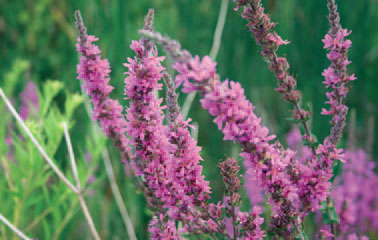Purple loosestrife
A fact sheet about purple loosestrife, an invasive wetland plant brought to North America in the early 19th century.
Purple Loosestrife (Lythrum salicaria)
Purple loosestrife is a wetland plant native to Europe and Asia that was brought to North America in the early 19th century. This highly invasive plant was likely introduced when its seeds were included in soil used as ballast in European sailing ships and discarded in North America. The plant was also spread by European settlers and is still used in flower gardens and occasionally sold in nurseries today.
Since it was brought to North America, purple loosestrife has become a serious invader of wetlands, roadsides and disturbed areas. The plant forms dense stands with thick mats of roots that can extend over vast areas. The stands reduce nutrients and space for native plants and degrade habitat for wildlife. Each plant can grow as many as 30 flowering stems that can produce up to 2.7 million seeds each year. The tiny seeds are easily spread by water, wind, wildlife and humans.
In 1992, the Canadian and American governments approved the release of two European leaf-eating beetles, Galerucella calmariensis and G. pusilla. The beetles are natural enemies of purple loosestrife and feed primarily on the plant, although they occasionally eat other species of loosestrife. This biological control of purple loosestrife can reduce populations by up to 90 per cent and allow native plants to re-establish. The beetles were widely released in Ontario, and purple loosestrife populations at many of these sites have been significantly reduced.
Range
Purple loosestrife was first introduced to the Atlantic coast of North America. From there, it spread westward across the continent to all Canadian provinces and all American states except Florida, Alaska and Hawaii. In Ontario, the plant has spread widely throughout the Great Lakes-St. Lawrence River Basin, and to scattered locations in the north around cities and towns such as Timmins, Geraldton, Sioux Lookout and Rainy River.


Impacts of purple loosestrife
- The plant forms dense stands with thick mats of roots that can spread over large areas, degrading habitat for many native birds, insects and other species.
- By crowding out native plants it reduces biodiversity.
- Large stands of purple loosestrife can clog irrigation canals, degrade farmland and reduce the forage value of pastures.

How to identify purple loosestrife
- One horizontal underground stem, known as a rhizome, can produce 30 to 50 erect stems. Stems are woody and square, and each one can form a plant up to 2.4 metres high and 1.5 metres wide.
- Individual flowers have five to seven pink-purple petals about 10 millimetres long, arranged on long flower spikes at the top of stems.
- Leaves are opposite or whorled and three to 10 centimetres long, with smooth edges.
Similar species that may be mistaken for purple loosestrife include fireweed (Epilobium agustifolium), blue vervain (Verbena hastata, blazing stars (Liatris spp.), native winged loosestrife (Lythrum alatum) and native swamp loosestrife (Decodon verticillatus).
What you can do
- Learn how to identify purple loosestrife and other invasive plants.
- The best time to remove purple loosestrife from your garden is in June, July and early August when it is in flower. Small areas can be dug by hand. Cutting the flower stalks before they go to seed ensures the seeds will not produce future plants.
- For more information on identifying and controlling purple loosestrife, see the brochure Purple Loosestrife: What You Should Know, What You Can Do. See Ontario's invading species awareness program's publications and downloadable resources.
- To dispose of purple loosestrife, put the plants in plastic bags, seal them, and put the bags in the garbage. Do not compost them or discard them in natural areas. Discarded flowers may produce seeds.
- Avoid using invasive plants in gardens and landscaping. Buy native or non-invsasive plants from reputable retailers. See Grow Me Instead: Beautiful Non-Invasive Plants for Your Garden and Stop the spread of invasive species.
- When hiking, prevent the spread of invasive plants by staying on trails and keeping pets on a leash.
- If you've seen purple loosestrife or other invasive species in the wild, please contact the toll-free Invading Species Hotline at
1-800-563-7711 , or visit Ontario's invading species awareness program to report a sighting.

Other resources:
- Invasive species centre
- Ontario invasive plants council
- Invasive species
- Ontario's Invading Species Awareness Program
For more information:
Please contact the Invading Species Hotline at
This fact sheet may be reproduced for non-commercial purposes.

© 2012
Cette publication est également disponible en français.